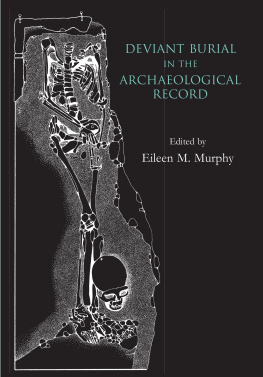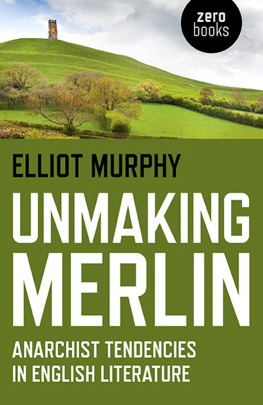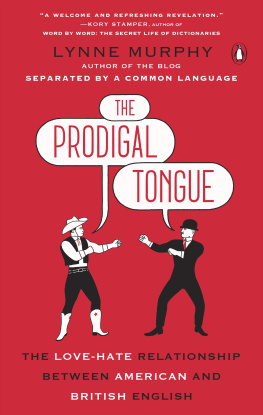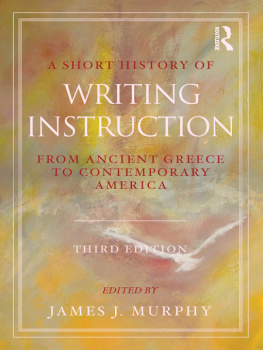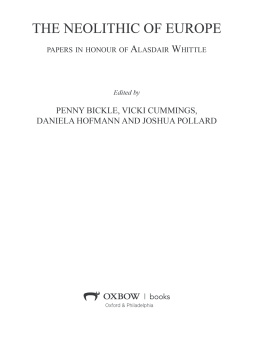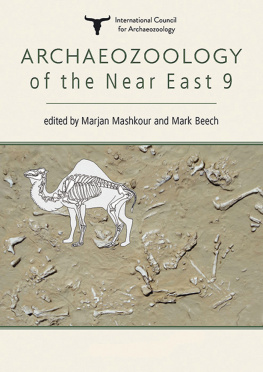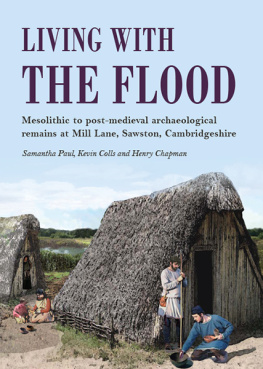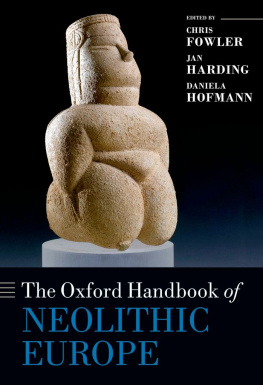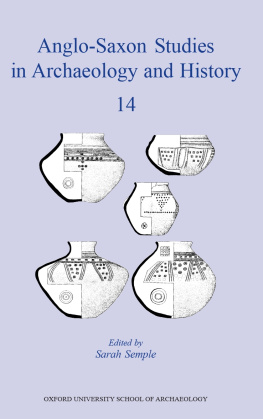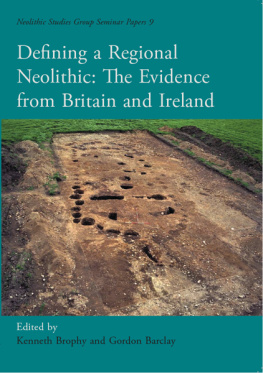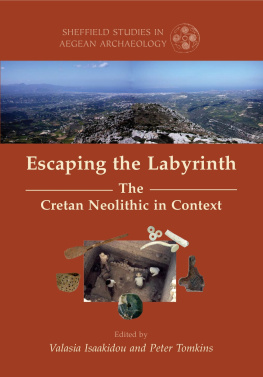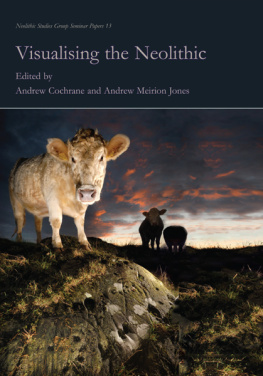Murphy - Deviant burial in the archaeological record
Here you can read online Murphy - Deviant burial in the archaeological record full text of the book (entire story) in english for free. Download pdf and epub, get meaning, cover and reviews about this ebook. City: Europe, year: 2008, publisher: Oxbow Books, genre: Religion. Description of the work, (preface) as well as reviews are available. Best literature library LitArk.com created for fans of good reading and offers a wide selection of genres:
Romance novel
Science fiction
Adventure
Detective
Science
History
Home and family
Prose
Art
Politics
Computer
Non-fiction
Religion
Business
Children
Humor
Choose a favorite category and find really read worthwhile books. Enjoy immersion in the world of imagination, feel the emotions of the characters or learn something new for yourself, make an fascinating discovery.
Deviant burial in the archaeological record: summary, description and annotation
We offer to read an annotation, description, summary or preface (depends on what the author of the book "Deviant burial in the archaeological record" wrote himself). If you haven't found the necessary information about the book — write in the comments, we will try to find it.
Abstract: This volume contains 12 papers that present evidence on non-normative burial practices from the Neolithic through to Post-Medieval periods and includes case studies from some ten countries
Murphy: author's other books
Who wrote Deviant burial in the archaeological record? Find out the surname, the name of the author of the book and a list of all author's works by series.
Deviant burial in the archaeological record — read online for free the complete book (whole text) full work
Below is the text of the book, divided by pages. System saving the place of the last page read, allows you to conveniently read the book "Deviant burial in the archaeological record" online for free, without having to search again every time where you left off. Put a bookmark, and you can go to the page where you finished reading at any time.
Font size:
Interval:
Bookmark:

This volume arose as a result of a session of the same name held at the 11th annual conference of the European Association of Archaeologists which took place in Cork, Ireland, in September 2005. I am very grateful to the conferences organisers and members of the Scientific Committee for enabling the session to take place and for providing an international forum which allowed the presentation of a wide range of fascinating papers on the subject of deviant burial. The volume would of course not have been possible without the efforts of all the contributors and I am extremely grateful to each of them for the efficient production of their papers and for their prompt responses to my various editorial queries.
I am also very grateful to Libby Mulqueeny of the School of Geography, Archaeology and Palaeoecology, Queens University Belfast, for her help with much of the illustrative material contained within the volume and for producing the front cover illustration. Thanks are also due to Richard Hall of the York Archaeological Trust for permitting a drawing of the decapitated male excavated from Driffield Terrace, York, to be used on the front cover of the volume.
Individual acknowledgements are included as appropriate in the papers which follow.
Anastasia Tsaliki
Unusual or deviant burials are considered to be cases where the individual has been buried in a different way relative to the norm for the period and/or the population under examination. Deformity and disease received scholarly attention in antiquity but, at the same time, they have also been the focus of social prejudice and superstition. Anthropological and ethnographical investigation has revealed that socially deviant and diseased individuals may receive different mortuary treatment relative to unaffected members of a society. In some cases, unusual disposal is accompanied by evidence for practices, which indicate fear of the dead (necrophobia). These practices usually include methods for the restriction of the dead in the grave by weighing down the body with large rocks, decapitation or the use of nails, wedges and rivets. For example, vampirism can be seen as a notion based on necrophobia, since legend indicates the vampire is a reanimated dead body. Anthropology and folklore have studied superstitional social fear for long but the Archaeology of Fear, based on the study and interpretation of evidence from the funerary archaeological record, is a relatively new concept. Although deviant individuals were not always treated differently in life or death, and were not necessarily regarded as outcasts or misfits, it is important for anthropologists and archaeologists to combine social, biological and burial data, as this approach may enable us to improve our understanding of atypical burials in the past.
In an effort to understand ancient humans, archaeology obtains a plethora of evidence from cemeteries and the burials within. By exploring the manner of death and the treatment of the dead it may be possible to gain a clearer picture of the livingof their society, practices and spirituality. Archaeological investigation has revealed the phenomenon of unusual burials: these are cases where an individual has been buried in a different way than what is considered the norm for the period and/or the population under examination. Unusual burials can also be termed atypical, anomalous, extraordinary, non-normative, abnormal or deviant.
The theoretical premise of the research presented hereinafter is that the type of burial together with the analysis of associated human skeletal remains may reveal significant information about the nature of the life, status, and manner of death of an individual. For instance, evidence of trauma, disease, and/or deformity in the skeleton may offer an insight into an individuals deviant treatment. An extensive literature review has been conducted for the purposes of establishing the necessary theoretical basis concerning death and its related subjects and to identify the usual burial customs and beliefs for the groups and periods under study. This was necessary to enable the detection and selection of the case studies included in the paper, and to enable these findings to be placed within their broader funerary context.
Unusual burials are often difficult to locate in the archaeological record as this depends on the experience of the excavators and recorders in addition to the background knowledge and aims of those responsible for interpreting the finds. Furthermore, it is difficult to associate every atypical burial with specific causes of crime or marginality. Both the bones and the burial context play an important role towards the achievement of this aim. As special treatment in the burial record can take many different forms within different cultures, a list of unusual human burial traits has been provided in . The list is not considered to be exhaustive, but rather as a reference guide to help with the adequate recording and categorisation of unusual cases.
In some cases unusual disposal is accompanied by evidence of practices, which appear to indicate fear of the dead (necrophobia). Necrophobia can be defined as a morbid fear of death and the dead. It is a term used also within medicine, which implies that the phobia may cause extreme and morbid reactions, such as intense anxiety, obsessions, or even a panic attack associated with acute distress, mental confusion and fear of impending death (Youngson 1992). It is a Greek word deriving from necros (), which means dead, and phobos (), which means fear, and in Latin it is known as terror mortis.
| Basic criteria applied to distinguish unusual burials: |
|---|
| Primary and secondary burials in unusual places and/or positions when compared to the ordinary burial customs of the cultural group or of the time period (e.g. skeletal remains in wells, pits or kilns, skeletons laid in a prone position). |
| Mass burials (inhumations and cremations), especially those without evidence or historical documentation for a crisis (e.g. epidemic, war, civil unrest) or those unique in the given burial ground. |
| Inhumations or cremations, in cemeteries or isolated, associated with indicators of unusual ritual activity (e.g. cut marks, unusual artefacts of possible symbolic or ritual use). |
| Cremations found in an inhumation site and vice-versa. |
| Skeletons with evidence that may be indicative of crime, torture or special mortuary ritual (e.g. victims of infanticide, senicide, human sacrifice, cannibalism). |
. Basic criteria applied to enable the identification of unusual burials.
Necrophobic practices usually include methods of restriction of the dead within the grave (). The fear of the dead seems to have had a substantial influence on burial customs from at least as far back as the Neolithic period, and it would appear to have had a worldwide impact (Tsaliki 2001).
It has been hypothesised that pathological conditions which cause deformities, pathologies that can affect an individuals mental state and behaviour, diseases with social stigma, or a violent death, may be linked to the nature of an individuals burial. Social marginalisation during life and/or death can occur for a wide variety of reasons, including disease (e.g. smallpox, leprosy, tuberculosis and other epidemic infections), congenital and mental conditions, an immoral life, murder, the nature of ones birth, family status, witchcraft, a curse, excommunication, heresy, death prior to baptism, violent death, death by suicide, and improper burial rites (Ucko 1969; Shay 1985; Sledzik and Bellantoni 1994). In his Natural History of AD 77, Pliny made a clear connection between a cross-eyed person and evil eye traditions. In Britain, information derived from folk superstition would tend to suggest that personal disability or deformity was often regarded as unlucky in the past (Roud 2004, 81).
Font size:
Interval:
Bookmark:
Similar books «Deviant burial in the archaeological record»
Look at similar books to Deviant burial in the archaeological record. We have selected literature similar in name and meaning in the hope of providing readers with more options to find new, interesting, not yet read works.
Discussion, reviews of the book Deviant burial in the archaeological record and just readers' own opinions. Leave your comments, write what you think about the work, its meaning or the main characters. Specify what exactly you liked and what you didn't like, and why you think so.

